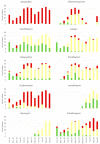Antimicrobial Resistance in Aquaculture Environments: Unravelling the Complexity and Connectivity of the Underlying Societal Drivers
- PMID: 36102785
- PMCID: PMC9631993
- DOI: 10.1021/acs.est.2c00799
Antimicrobial Resistance in Aquaculture Environments: Unravelling the Complexity and Connectivity of the Underlying Societal Drivers
Abstract
Food production environments in low- and middle-income countries (LMICs) are recognized as posing significant and increasing risks to antimicrobial resistance (AMR), one of the greatest threats to global public health and food security systems. In order to maximize and expedite action in mitigating AMR, the World Bank and AMR Global Leaders Group have recommended that AMR is integrated into wider sustainable development strategies. Thus, there is an urgent need for tools to support decision makers in unravelling the complex social and environmental factors driving AMR in LMIC food-producing environments and in demonstrating meaningful connectivity with other sustainable development issues. Here, we applied the Driver-Pressure-State-Impact-Response (DPSIR) conceptual framework to an aquaculture case study site in rural Bangladesh, through the analysis of distinct social, microbiological, and metagenomic data sets. We show how the DPSIR framework supports the integration of these diverse data sets, first to systematically characterize the complex network of societal drivers of AMR in these environments and second to delineate the connectivity between AMR and wider sustainable development issues. Our study illustrates the complexity and challenges of addressing AMR in rural aquaculture environments and supports efforts to implement global policy aimed at mitigating AMR in aquaculture and other rural LMIC food-producing environments.
Keywords: Antimicrobial resistance; DPSIR; LMIC; antibiotic; aquaculture; environment; food production; framework.
Conflict of interest statement
The authors declare no competing financial interest.
Figures





References
-
- The Future of Food and Agriculture - Trends and Challenges; FAO: Rome, 2017.
-
- Antimicrobial Resistance and the United Nations Sustainable Development Cooperation Framework: Guidance for United Nations Country Teams; Food and Agriculture Organization of the United Nations, World Organisation for Animal Health, World Health Organization, 2021.
-
- Murray C. J.; Ikuta K. S.; Sharara F.; Swetschinski L.; Robles Aguilar G.; Gray A.; Han C.; Bisignano C.; Rao P.; Wool E.; Johnson S. C.; Browne A. J.; Chipeta M. G.; Fell F.; Hackett S.; Haines-Woodhouse G.; Kashef Hamadani B. H.; Kumaran E. A. P.; McManigal B.; Agarwal R.; Akech S.; Albertson S.; Amuasi J.; Andrews J.; Aravkin A.; Ashley E.; Bailey F.; Baker S.; Basnyat B.; Bekker A.; Bender R.; Bethou A.; Bielicki J.; Boonkasidecha S.; Bukosia J.; Carvalheiro C.; Castañeda-Orjuela C.; Chansamouth V.; Chaurasia S.; Chiurchiù S.; Chowdhury F.; Cook A. J.; Cooper B.; Cressey T. R.; Criollo-Mora E.; Cunningham M.; Darboe S.; Day N. P. J.; De Luca M.; Dokova K.; Dramowski A.; Dunachie S. J.; Eckmanns T.; Eibach D.; Emami A.; Feasey N.; Fisher-Pearson N.; Forrest K.; Garrett D.; Gastmeier P.; Giref A. Z.; Greer R. C.; Gupta V.; Haller S.; Haselbeck A.; Hay S. I.; Holm M.; Hopkins S.; Iregbu K. C.; Jacobs J.; Jarovsky D.; Javanmardi F.; Khorana M.; Kissoon N.; Kobeissi E.; Kostyanev T.; Krapp F.; Krumkamp R.; Kumar A.; Kyu H. H.; Lim C.; Limmathurotsakul D.; Loftus M. J.; Lunn M.; Ma J.; Mturi N.; Munera-Huertas T.; Musicha P.; Mussi-Pinhata M. M.; Nakamura T.; Nanavati R.; Nangia S.; Newton P.; Ngoun C.; Novotney A.; Nwakanma D.; Obiero C. W.; Olivas-Martinez A.; Olliaro P.; Ooko E.; Ortiz-Brizuela E.; Peleg A. Y.; Perrone C.; Plakkal N.; Ponce-de-Leon A.; Raad M.; Ramdin T.; Riddell A.; Roberts T.; Robotham J. V.; Roca A.; Rudd K. E.; Russell N.; Schnall J.; Scott J. A. G.; Shivamallappa M.; Sifuentes-Osornio J.; Steenkeste N.; Stewardson A. J.; Stoeva T.; Tasak N.; Thaiprakong A.; Thwaites G.; Turner C.; Turner P.; van Doorn H. R.; Velaphi S.; Vongpradith A.; Vu H.; Walsh T.; Waner S.; Wangrangsimakul T.; Wozniak T.; Zheng P.; Sartorius B.; Lopez A. D.; Stergachis A.; Moore C.; Dolecek C.; Naghavi M. Global burden of bacterial antimicrobial resistance in 2019: a systematic analysis. Lancet 2022, 399, 629–655. 10.1016/S0140-6736(21)02724-0. - DOI - PMC - PubMed
-
- Global Action Plan on Antimicrobial Resistance; World Health Organization, 2015. - PubMed
Publication types
MeSH terms
Substances
LinkOut - more resources
Full Text Sources
Medical

